As we enter the second quarter of 2023, the business world is eagerly anticipating the return of corporate travel. With more people getting vaccinated and the global economy starting to bounce back from the pandemic, there’s no doubt that business travel is on the upswing.
However, it’s important to note that the way people travel for business has changed significantly over the past few years. While the traditional business trip is making a triumphant return through in-person conferences and meetings, conference goers are not the only ones utilizing hotels to get their work done. Plus, many Americans are putting more emphasis on a healthy lifestyle following the COVID-19 outbreak, according to Pew Research Center.
As a result, the hospitality industry needs to be mindful of these changes in order to attract more corporate travelers to their hotels.
In this blog post, we’ll take a closer look at three ways business travel has evolved since the pandemic and what that means for the hospitality industry moving forward.
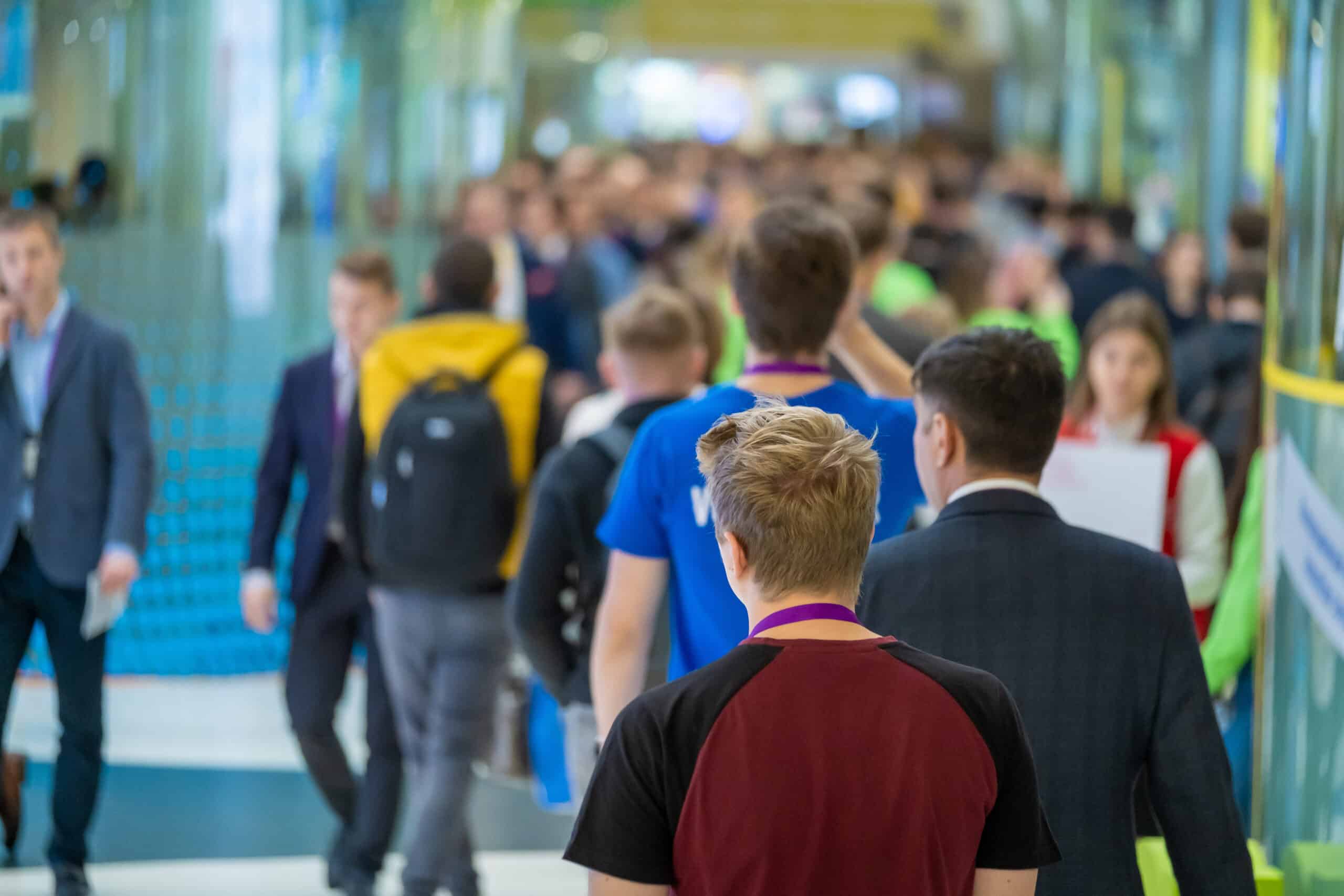
With strict travel restrictions, stay at home orders, and health concerns during the height of the COVID-19 pandemic, it’s no surprise that the events industry suffered tremendously. While virtual events served as a serviceable alternative during the pandemic, there is simply no substitute for the in-person connections and experiences that can be gained from attending a live event.
Fortunately, Knowland, a data and hospitality technology company, is optimistic the event industry will be back to 100 percent by the end of 2023.
As the event industry continues its recovery, Knowland’s optimism is great news for hotels that have been struggling to bounce back after the pandemic. The return of conferences, trade shows, and other business events is a key factor in the recovery of the hospitality industry, and the fact that Knowland is predicting a full return to pre-pandemic levels is certainly cause for celebration.
but….
Between meetings, conferences, and networking events, business travelers are always on the go. But one thing that’s not on their itinerary? Getting sick. So it’s no surprise that travelers are still prioritizing health and safety when it comes to their accommodations.
According to a survey conducted by Pew Research Center, 26% of respondents said keeping healthy became more important to them during the COVID-19 pandemic.
From hand sanitizer stations to contactless check-in and touchless hydration stations, there are a variety of measures that you can take to show your guests that their health is your top priority.
But, are conference and trade show attendees the only ones working from hotels?
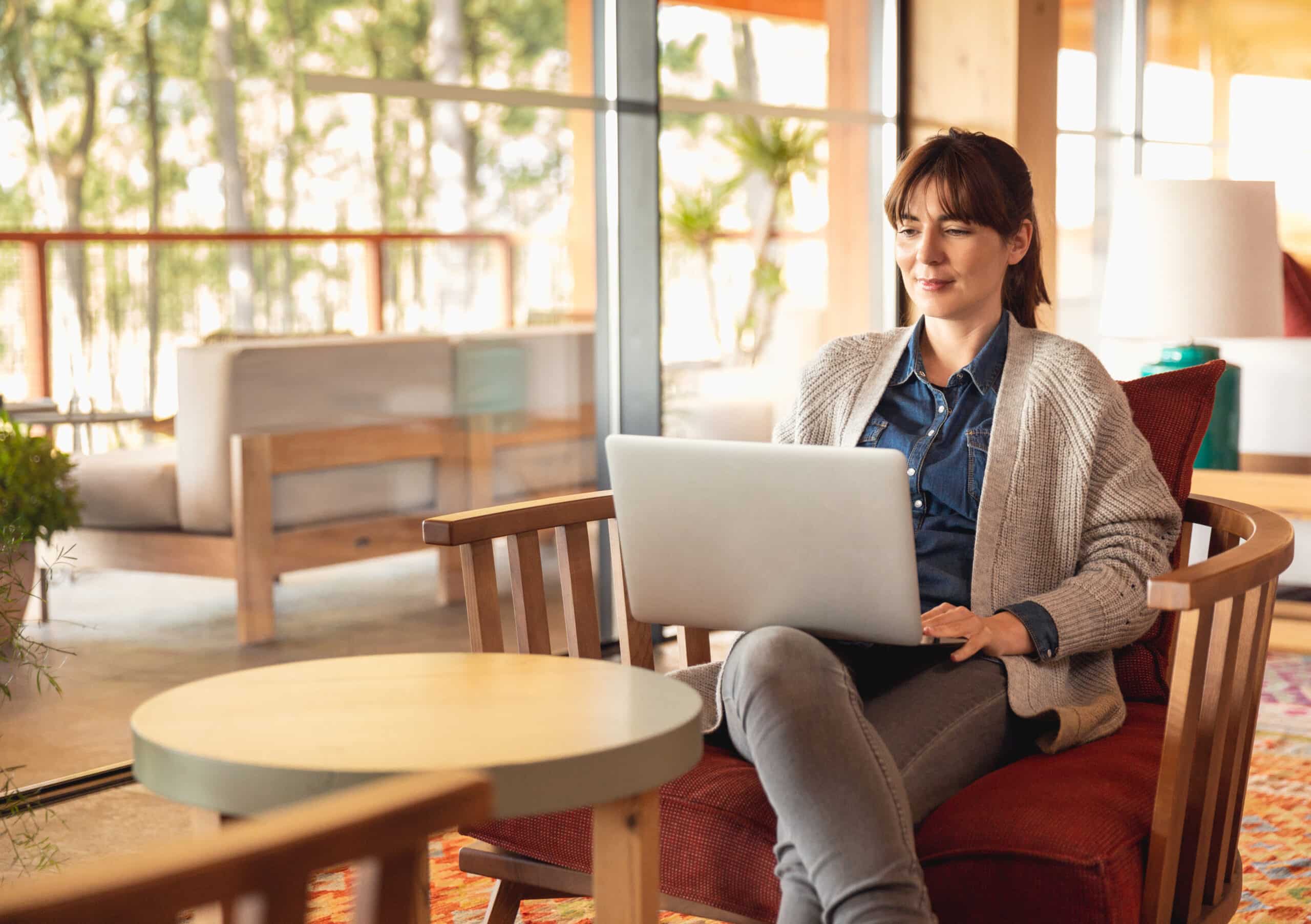
With more and more companies embracing flexible work arrangements, many employees are now able to work from almost anywhere that has an internet connection. This has not only changed the way people work, but also the way they travel for business.
Hotels should prioritize offering guests amenities and services that cater to both business and leisure travelers, as some remote workers are making the most of their working situations by extending their business trips into vacations.
When catering to these business travelers, hotels should consider amenities that remote workers would expect in an office environment, such as free coffee, healthy beverages like water or seltzer, and great wifi.
From high-speed internet to fitness facilities to co-working spaces, there are many ways that hotels can appeal to the growing number of remote workers who are eager to travel and explore new destinations while staying connected to their work.
Download our guide today: “Is the Business Trip Back? What water coolers can tell us about post-COVID work travel and how the hospitality industry can adapt to these trends.”
Click here to download now.
If you think your office is on the road to sustainability, you’re probably starting to take some positive steps toward lowering your environmental impact. Even so, a recent report might have you wanting to check in with your employees about your sustainability report card from their perspective.
In a survey of 2,000 office workers, intranet company Unily found that 83% of employees felt their employer wasn’t doing enough to tackle sustainability issues, and 65% also said they would be more likely to work for a company with a strong environmental policy. In the age of the “Great Resignation,” it’s clear that you can’t afford to fall behind competitors on the sustainability front.
If you want to get smart about sustainability in your office, one easy way forward is with a Bevi smart water cooler. Why choose Bevi? It turns a human necessity into a unique office perk that can be customized by each and every employee, save your company money, and prevent plastic bottles from ending up in the landfill. It’s even more than that, too…
Meet Bevi: The Smart Water Cooler from Bevi on Vimeo.
While some snacks and break room diversions can be fun extras, a refreshing glass of water is something we can all agree on as being essential to get us through the workday. The best part is that, with Bevi, coworkers don’t have to agree on anything past that.
With over 48,000 drink combinations to choose from with our Standup 2.0, a glass of Bevi water is customizable from the temperature to the bubbliness to the flavor and enhancements. What’s more, it’s a delightful addition to any office that will provide a natural place for coworkers to gather and get back in the habit of in-person collaboration.
Speaking of flavor and enhancements, you’ll have the power to decide what’s in your glass and what’s not, with complete transparency around the nutritional value of any additions. For starters, all of our flavors and enhancements are sodium-free, gluten-free, vegan, and devoid of any artificial ingredients. They’re made from real fruit essence to create delicious combinations like Blackberry Lime, Strawberry Lemongrass, and Peach Mango.
If you need a boost, try one of our healthy enhancements, Electrolytes, Caffeine or Immunity. Staying healthy at the office is easy with a fun way to hydrate and extra health benefits in every glass.
In addition to investing in your employees with a healthy refreshment option, Bevi water coolers are a smart investment when it comes to the bottom line. On average, our machines are 40-60% less expensive than purchasing single use bottles and cans.
They’re also a time saver, eliminating extra tasks for your office manager so they can increase productivity in other areas of the business. Gone are the days of lifting heavy water jugs and cases of seltzer water. Because our water dispensers are internet-enabled, we do the monitoring and restocking for you. All the necessary parts–flavors, filters, and CO2 levels–are seamlessly replaced to keep your office happily hydrated.
Your recycling bin is about to get a whole lot lonelier. One Bevi machine can displace over 30,000 bottles and cans per year. Bevi customers have saved over 200 million bottles to date, not to mention the oil necessary to make plastic bottles or the carbon emitted once they’re filled with water and shipped all over the country.
Want to motivate your team to up their sustainability game? You can monitor your own machine’s impact by navigating to the “Explore” tab on the touchscreen. A real-time counter shows the bottles and cans you’re saving, as well as what that translates to in terms of carbon and trees.
It’s clear that employees want their workplaces to take a more active role in sustainability efforts, and the Bevi Standup 2.0 water dispenser is an easy way to invest in the health of your workforce while also being mindful of the environment.
With thousands of possible drink combinations, every employee will find their favorite flavor and keep track of their personal sustainability journey as well. A Bevi water dispenser in the office means happier employees, lower costs, and a visible commitment to sustainability.
Ready to join over 4,000 companies using Bevi today? Get a quote for your office today.
In a survey by global design and architecture firm, Gensler, only 12% of U.S. workers want to work from home full-time. Most want to return to their offices and workplaces – but only with changes that protect them from Covid-19.
An abundance of floor graphics reinforcing safe distancing, corridors with one-way foot traffic, and mask-wearing co-workers are likely to be among the differences we see at work. It won’t just be the look of our offices that will be different, how we do what we do in those spaces will change as well.
A key to safety is limiting touchpoints. That’s generating some intriguing ideas of what you could expect in the new touchless workplace. The ubiquitous restroom messaging requiring all employees to wash hands before returning to work will likely resonate deeper and wider in most workplaces. MarketWatch makes a similar prediction that “consumers will make contactless experiences and sanitizing a part of daily life.”
We only need to look at Hong Kong to get a sense of what that could be. After the SARS epidemic in 2003, major public health changes were put in place, including more automatic doors and no-touch payment methods.
Personal devices will play a much larger role at work. Their Bluetooth, Wi-fi, and LTE capabilities provide easy-to-use and well-established access technology for just about any kind of touchless solution.
It’s not hard to envision gaining entry to a building using Bluetooth to open an automatic door, eliminating an ID card swipe or fingerprint scan. Apps could also find their way into ordering food from company cafeterias or providing touchless operation of vending machines and office water dispensers.
Even simpler than using our phones will be using our hands. While hands-free bathroom fixtures were gaining popularity well before the pandemic, more advanced gesture control technology is already being implemented in some buildings. Lakeside Center, an office and retail center under construction in Columbia, MD, will include touchless controls that allow people to ride elevators and open doors with a hand wave.
Voice-activated virtual assistants, like those we use at home and in our cars, could also be joining us at work. Their track record of integrating voice control with a variety of devices could make them useful in instances where apps or gestures might be too clunky or responsive to work. In offices and conference rooms, your voice could dim lights, turn on projectors, and adjust the temperature. Gensler envisions expanding voice-control to also handle both touch- and non-touch-related tasks, “Combine these two elements in a workplace setting and the potential is immediately appealing: “unlock my office,” “order my usual lunch in 10 minutes,” or even “setup a meeting for me with John tomorrow at 3 p.m. in a conference room for two.”
While much of the Touchless Workplace has come about in response to the coronavirus, it could provide benefits well into the future. Limiting the need to touch surfaces and objects will reduce germ-spread in general, keeping us all healthier. It can also make the time we spend at work more enjoyable and efficient. For example, the same technology that monitors occupancy to support social distancing could also be used for something as routine – but essential – as finding an open conference room. So, while our first day back in our old workplace may feel more like the first day in a new one, we may find that many of the touchless changes we encounter may be well worth embracing (although not literally).
We often hear that we need to drink enough water each day (generally, about 15.5 cups for men and about 11.5 cups for women). And since most of us spend a good part of that day at work, we took a look at some of the benefits of drinking water on the job.
Whether you’re in the office, working from home, stationed at a checkout register, or down on the warehouse floor, there’s a good chance you’re spending some time in front of an electronic screen. According to some studies, that can be as much as 6.5 hours daily. And that’s not counting all the screen time we log away from work.
That’s an eyeful for your eyes. It’s a good idea to give them a break and take a walk to grab some water.
Our eyes are 98 percent water, so they’re easily affected by how much water we consume. Having an office water dispenser can help you stay properly hydrated and greatly reduce many common eye ailments, such eye strain, blurred vision, and dry eyes.
Our eyes take in information that our brains then interpret, analyze, and act upon. Water comes into play here as well. When we don’t take in enough water, our blood volume decreases, lowering blood pressure. If you’ve ever felt lightheaded, dizzy, or even just a bit foggy or tired later in the day, it could be due to insufficient hydration.
While a glass of water can offer some relief at the time, experts recommend regular, steady water consumption throughout the day to remain sharp and alert.
Spending too much time in a chair or too much time on your feet can both negatively affect muscles and joints, especially if we don’t drink enough water at work. Water helps muscles contract and relax. It also helps keep muscle cells hydrated. That can offset the muscle strain and cramps that often come with too much chair time or too much time on the floor at work. It’s much the same story with our joints. Water keeps them well lubricated and helps remove toxins from the body to fight joint inflammation.
Continuing to drink water after we close our laptops and turn out the lights is important, too. Our bodies do most of their recovery and repair work while we sleep. Water plays a key role in replenishing our systems and helping us regain proper physiological balance, which means we wake up feeling rested and refreshed to take on another day at work.
We mentioned earlier that water flushes out toxins in our bodies. But if we don’t consume enough water, the toxins can build up and our immune system has to work harder to manage them. Good hydration supports a strong and stable immune system that can fight off viruses and bacteria that make us sick and keep us out of work.
No matter what we do at our jobs, each of us would like to be as productive as possible, right? That’s one more area where water can make a significant difference. A 2013 study conducted by the University of East London showed that drinking water can result in a 14% increase in productivity. It stands to reason that something as simple and easy as making a few trips to the office water cooler or water dispenser each day could help us do more at work, stay healthier doing it, and feel better about it when we wake up the next day.
A popular way of maintaining our wellbeing with lockdowns, shutdowns, and working from home is just getting outside. A study by Danish urban research firm, Gehl, reflects this new attraction to nature. One study respondent commented, “People seem to be using greenspace and outdoor space more than pre-outbreak — but now, even more so, it is a release, an escape, some sanity, some wellness.”
With this growing popularity comes a lot of our trash. The litter that registers as invisible when we drive by becomes all too noticeable at the tamer pace of a leisurely walk around the block. A plastic shopping bag lodged at the base of a hedge. Old bottles, cans, and other trash along the curb.
Much of this waste finds its way to streams, rivers and other waterways, and eventually to the oceans. However, researchers in Germany found that one third of all plastic waste ends up in the ground or in freshwater. Most of this is unintentional. The Center for Outdoor Ethics found 9 out of 10 people in the outdoors are uninformed about how they may adversely affect the environment.
Good news. There are indications that more people are aware of their impact on the greenspaces, woodlands, waterways and oceans that offer us much needed solace. For example, the program Plastic Free July, has been working since 2011 to help create a world free of plastic waste. In 2020, they saw their highest level of engagement with 326 million people participating in the Plastic Free July challenge. That’s up 100 million from the year before.
More good news. It’s not hard to build on the success of initiatives like Plastic Free July. We can easily take care of our outdoor refuges with just a little forethought and planning.
Here are some great ideas from the National Park Foundation:
Stay hydrated but leave the plastic water bottle at home and grab a refillable one instead.
Being well-nourished is just as important, so use reusable silicone snack bags on the trail.
Bring food in reusable containers and use washable napkins and tablecloths.
Ditch the plastic and invest in reusable straws, plates, and cutlery that can be easily rinsed clean.
About 30 percent of all trash in the U.S. comes just from product packaging, so try to reduce single-use packaged food products as much as possible.
Instead of paper maps, make use of several national park map apps. No service? Many parks apps can be downloaded ahead of time and used offline.
Don’t plan on finding a trash or recycling can. Always plan ahead and decide how you’ll store any garbage until you’ve reached a proper disposal site.
Maintaining our oceans, waterways, and greenspaces spaces is not only essential for the planet’s wellbeing, it’s becoming more essential for our wellbeing. And to take care of the latter, we need to take care of the former.
Research has shown that the simple act of doing something good, such as keeping the environment clean and healthy, can actually make us feel good in the process. And isn’t that why we took that long walk outdoors in the first place?
It’s an average morning at work and you’re sitting there going through your emails and as you’re sipping on a hot coffee in a styrofoam cup, the teammate working nearby tosses his first plastic water bottle of the day in the trash bin under his desk. At the same time, someone around the corner is changing the printing cartridges and throwing the used ones away while someone else opens an energy bar wrapper in the breakroom. You go to write something down on your notepad but the pen has gone dry, so you throw it like a basketball at a bin across the room, swish! The amount of single-use products that office workers use in a single day can really be astonishing. For someone who works in an office, the average amount of waste they generate is 4.4 pounds per day. Then if you consider the number of people who work office jobs, the amount of waste created becomes almost unfathomable. Much of this waste can actually be recycled but the current infrastructure and patterns of behavior in most American offices has left us with a waste-generation problem. Recently the issue of microplastics, a symptom of the disease that is plastic waste, is creating serious health risk issues for humans across the globe, potentially including yourself.
Anything that you use in your office that is made with plastic materials (e.g. pens, plastic bottles and cups, cutlery, coffee pods, etc.) either ends up in a landfill or sewage. In that landfill, the plastics break down into tiny pieces about the size of sesame seeds or even smaller (5mm or less in length). These are microplastics and from the landfill, these small but mighty plastic shards leak out of landfills and end up washed into nearby waterways such as rivers and ponds. Water filtration systems fail to stop these harmful materials from reentering our lives. They eventually make their way via those waterways into the oceans and lakes, into the fish and other animals that we consume, the water that we drink and even into the air that we breathe. Humans can come into contact with microplastics through ingestion, inhalation, and skin contact, and can cause health issues like cancer, organ failure, diabetes, neurological and reproductive issues, amongst others. These microplastics are pervasive across the globe and scientists don’t fully understand the extent of this problem or the long term impacts they could have on human health and the environment. What scientists do know, however, is that these materials are extremely harmful to marine life in the short-term, this puts an essential nutritional resource to many cultures across the globe at risk.
While you may think that you can avoid microplastics simply by not eating fish, unfortunately, that is not the case. Researchers at the University of Victoria in Canada analyzed microplastics levels in the bodies of various people and found the biggest sources of microplastic to be not only from seafood but also from the air they were breathing and bottled water they were drinking. That’s right, bottled water! The very thing that is breaking down and creating the microplastic problem in the first place. An article in Time magazine states, “when people drink their water only from bottled sources, they ingest about 90,000 microplastic particles every year from that water, but people who drink only tap water get 4,000 of such particles a year”. This fact is shocking and certainly has left us with a distrust of bottled water here at Bevi. Because we know that microplastics are harmful to our bodies, we need to start to reduce the amount that we are allowing to enter the environment and ultimately our food chain. It is not enough to simply get better at recycling single-use plastic products. We also need to work at not creating them in the first place. Workspaces and offices are one of the largest sources of plastic pollution and there are so many ways these spaces can be altered to be better for the environment and better for the health of their employees. Read on!
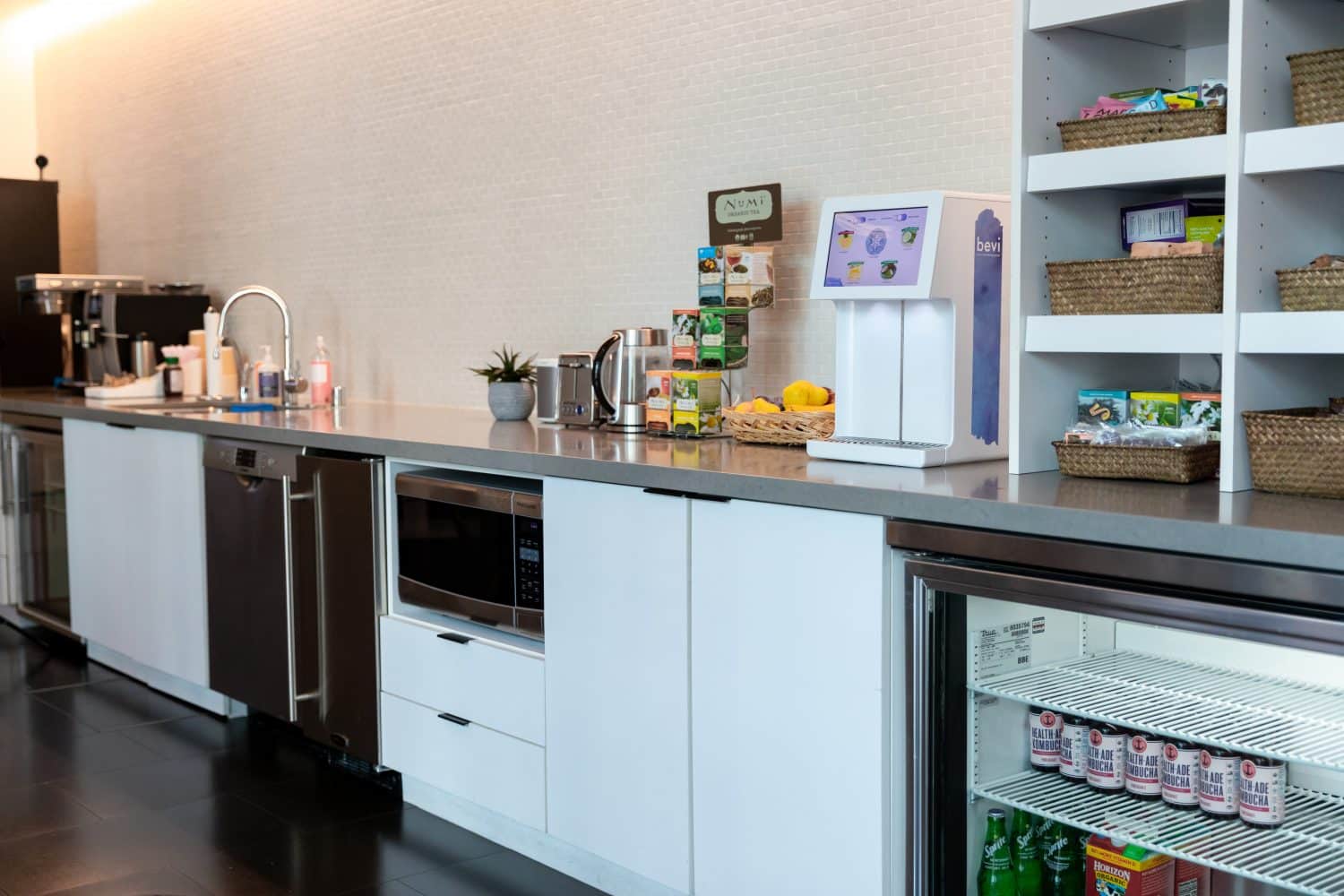
Office managers and eco-friendly workplace warriors can really help when it comes to combating the issue of plastic waste and microplastics. Initially, there might be some investment needed in order to move away from things like single-use plastic forks and spoons and toward reusable silverware that is much better for the environment. There may be other hurdles to overcome, such as not having a good recycling program in your area. There may also be some pushback from co-workers initially, who are used to having their iced coffee in plastic cups every day or who just don’t see the urgency in changing their behavior. Here are some steps you can take to reduce the amount of plastic waste coming from your office and in turn you will be helping to reduce the amount of microplastics in your surrounding environment. Ultimately your company and your co-workers will thank you.
 There are so many great zero-waste influencers on social media these days and they are helping to teach others about all of the great DIY projects and eco-friendly products they use in order to reduce the amount of waste they generate. You can follow a lot of these folks on Instagram such as the waterthruskin and get inspired to go waste-free yourself. Follow accounts like zero.waste.collective that provide tips on things like creating a zero-waste dishwashing routine. That’s something you could implement in the office!
There are so many great zero-waste influencers on social media these days and they are helping to teach others about all of the great DIY projects and eco-friendly products they use in order to reduce the amount of waste they generate. You can follow a lot of these folks on Instagram such as the waterthruskin and get inspired to go waste-free yourself. Follow accounts like zero.waste.collective that provide tips on things like creating a zero-waste dishwashing routine. That’s something you could implement in the office!
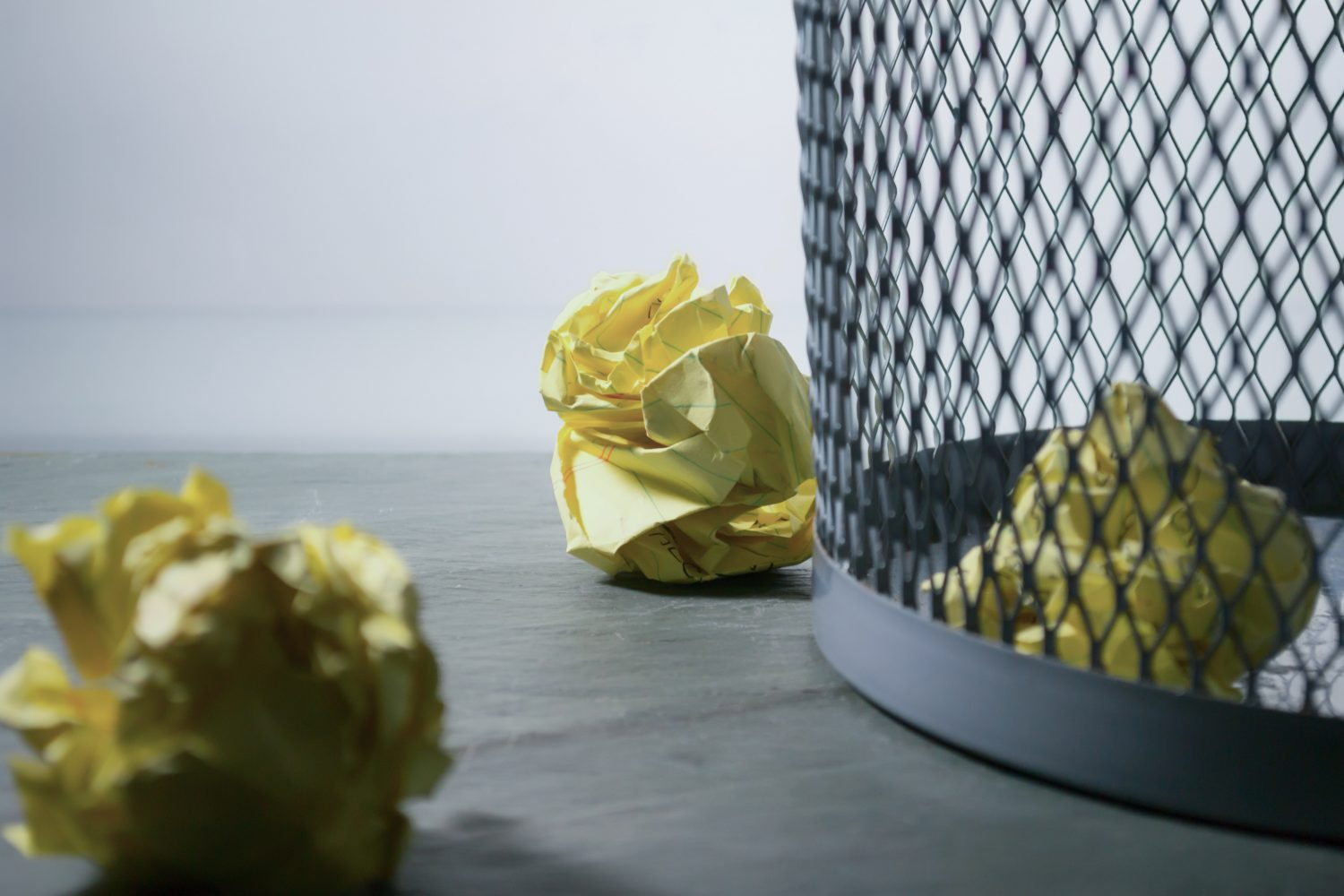
In order to make changes, one often has to find the urgency to do so. There is no way to find the urgency unless you know how much you are actually wasting. A good way to do this is an office-wide trash audit. It can be eye-opening and will spark behavior change amongst your co-workers. In order to do this, take a trash bin from different parts of the office including the breakroom, the printer room, conference room, or whatever other rooms you may have. Dump it out and with gloves on go through it, and write everything that you find in there on a whiteboard or piece of paper. If there is more than one of something, for example, multiple plastic cups, just put extra tally marks next to that item on your list. If you’re noticing one type of garbage taking up most of the space in the bin, you might try to make that the first thing you try to switch from disposable to reusable. You can even share with the rest of the company what you found, and give them the heads up that there might be some small changes coming their way.
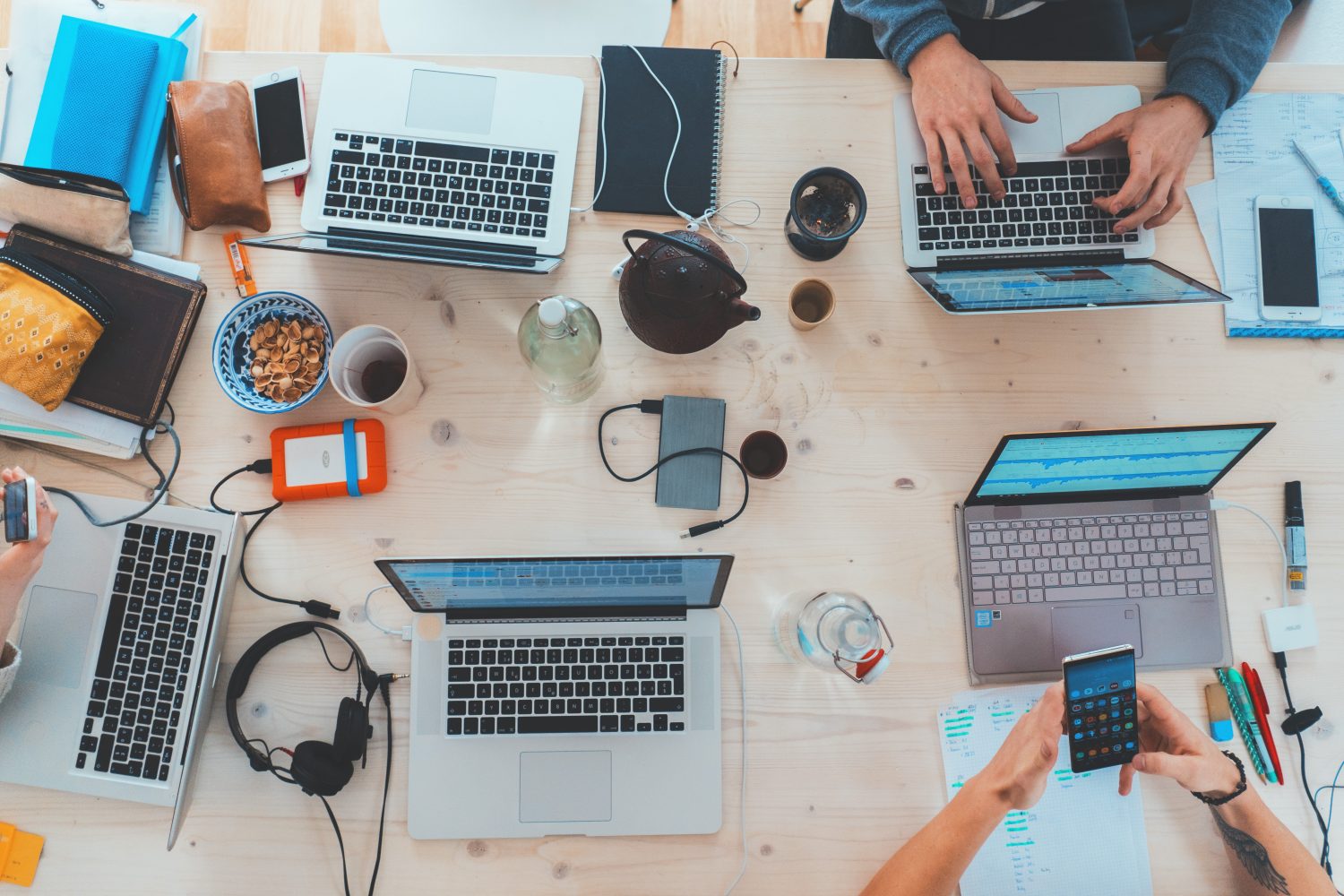
To get buy-in, tell the people in your office why these changes are important and thank them for working with you to make your office healthier and more sustainable. Start a BYOB initiative and encourage people to bring their own reusable coffee cup and/or a reusable water bottle. If your company can, a good way to discourage the use of disposable plastic products is by supplying team members with company-branded water bottles or travel mugs! Plus when they’re using the cups out-of-office, these can serve as free advertisements for your business!. Motivate team members to pack lunch from home and avoid eating out. This might be difficult to get everyone to do, but try tying this initiative in with a healthy-eating initiative. Something that would help start this process would be to make sure you have a refrigerator where your co-workers can store their lunches, and perhaps even a dishwasher if possible. Employees can go one step further and bring bamboo or metal cutlery and their own reusable straws. Every little thing helps! The most important part of this part of the process is raising awareness across the company. Choose someone to spearhead and be the face of the zero-waste initiative. You can incentivize your co-workers by putting different teams in competition with one another to see who can reduce their plastic waste the most in the upcoming months.
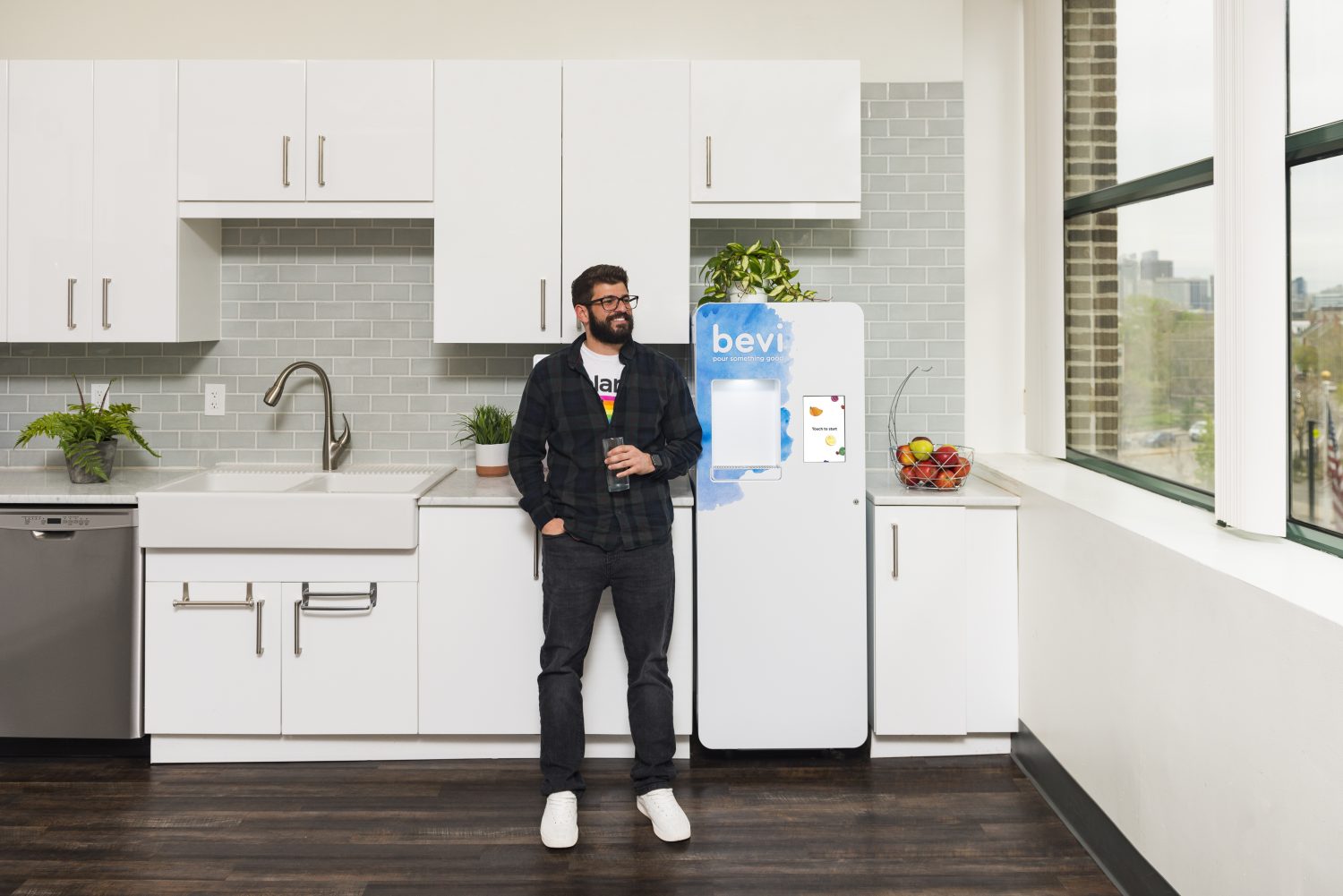
Now that you got everyone using their reusable coffee mugs and water bottles, it’s time to take things up another level. There are tons of innovative products on the market that are specifically meant to reduce the amount of office waste that a business might generate. Bevi is an awesome way to inspire employees to refill their bottles all day long and save office managers from the stress of restocking shelves with beverages. With Bevi, your co-workers can completely customize their beverage with carbonation or different flavors. This makes the hydration experience throughout the workday much more exciting and generally reduces the amount of dehydrated and angry people in the office. Bevi is often cheaper than continuing to buy and stock tons of single-use seltzer cans or plastic water bottles. Additionally, if you have anyone coming to the office, the Bevi is a fun way to entertain your guests while also providing them a delicious and healthy beverage.
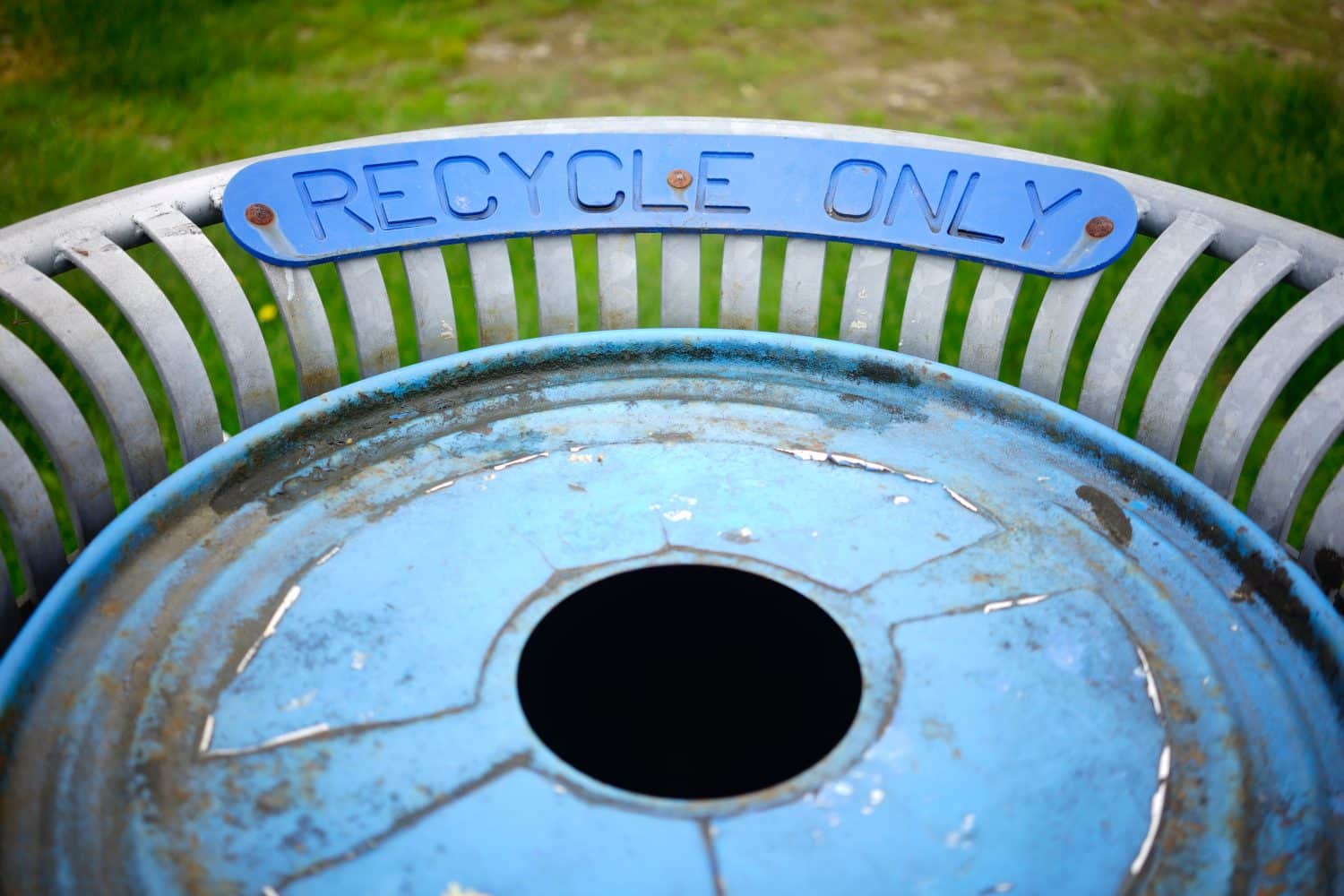
Recycling is not standardized throughout the US and often much of what we think we’re recycling ends up in landfills anyway. Some cities are better at recycling than others, so it’s important that if you are trying to become zero-waste in the office, you should research the recycling programs for your general area. If you find that the recycling programs in your area are inadequate, there is a company called TerraCycle who is ready to help you! TerraCycle has various programs and products aimed at eliminating the idea of office waste. The Break Room Separation Zero Waste Box™ is a good way to collect all of the recyclable material from your breakroom. TerraCycle will provide you with points that can be redeemed for various prizes or exchanged for money toward a charity of your choice.
We spend so much of our lives in our workplaces and within those spaces, we each generate a huge amount of waste. Most of that is plastic waste that ends up as harmful microplastic particles that could harm the health of our employees and co-workers later down the line. Shouldn’t we all be taking steps to reduce the amount of waste we generate during the workday? Hopefully, this information and our tips will help you kick off a zero-waste initiative in the office, and please share this article with other office managers if you found it helpful!
Many companies these days understand the importance of retaining brilliant young talent as well as the cost associated with high turnover rates. Over the past decade, it has become increasingly common to invest in corporate perks such as ping pong tables and bean-bag chairs, napping pods and meditation rooms. While these office additions may help with employee burnout, there isn’t much evidence that they address the actual wants and needs of employees when it comes to their health and wellness in the workplace.
One Havard study that looked into the wellness programs of various large US companies and found that 80% of those programs lead to less-than-satisfactory results. Much of this had to do with the types of perks that were a part of the wellness programs, which were not actually addressing the issues that mattered most to the majority of employees.
Another study dove deeper into this idea of “perks” to discover which were the most important to employees and their productivity. This found that air quality, comfortable lighting, and great water quality were the 3 most important wellness perks from a survey of 1,600 workers. These three categories were more important than having healthy snacking options and even fitness centers on-site. This was due to their power to promote not only the employee’s physical wellness but also their emotional and environmental wellness.
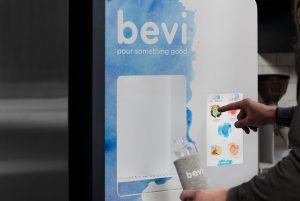
Water quality as an essential perk stood out to us here at Bevi because we’ve seen first-hand how increasing hydration in the workplace has benefits in productivity and general employee satisfaction. Workers that are dehydrated are usually lower energy, more irritable, and less focused and alert during the day. A large part as to why this occurs is because the hydration options in most offices are limited, uninteresting, or unhealthy.
While plenty of office managers and business owners offer freshwater for their employees, coffee and sodas are also extremely popular. Those options are less healthy than water and definitely do not have the maximum hydrating power that H2O does. Coffee and soda are historically less boring than water and when they need a break from their busy day, sometimes employees want to sip on something a little bit more exciting than plain old water.
The lack of exciting options leads many team members to forget about hydrating all together, which brings on those other symptoms of dehydration discussed earlier. It is through solutions like Bevi, the smartest and most exciting watercooler around, that office managers can boost the “water quality perk” in the office and also increase retention and performance. Employees hydrate more times throughout the day when using Bevi because they can completely customize their beverage to their liking, adding carbonation and flavors, as well as adjusting the temperature of the water. The flavoring has little or no calories and is created using natural ingredients that are gluten-free and kosher. That means that with Bevi, there are options for everyone in the office from the soda-loving accountant to the seltzer-obsessed communications manager.

Human Resources managers and Wellness Directors should look into how Bevi can be an addition to your company-wide wellness programs and initiatives. We now know that increasing the water quality and options at work can help dehydrated employees struggling to get through the long workday, and we think Bevi takes that to another level by bringing excitement back into staying hydrated. A less dehydrated workforce is a higher-performing and happier workforce and that is key to retaining top talent these days.
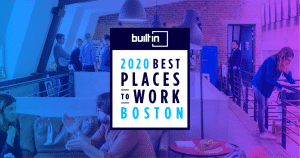
We are excited to share that Bevi has been honored in Built In Boston’s Prestigious Best Places to Work List in 2020. Bevi is ranked #24, and the complete list is available here.
Built In Boston helps Boston tech professionals stay on top of tech news and trends, expand their networks and carve out futures at companies they believe in. The Places to Work list rates companies algorithmically based on compensation data and employer benefits. Rank is determined by combining a company’s score in each of these categories.
Located in Charlestown, Bevi is disrupting the beverage supply chain by using intuitive, user-centered design to provide customizable, healthy beverages at the point of use – and to save the waste generated by over 150 million plastic bottles, and counting.
“I really wanted to work for a company that shared my values, and Bevi’s environmental mission really aligns with who I am. Since I started, Bevi has tripled in size. My role has changed so much along the way: I started as a Sales Assistant working mainly behind the scenes, and now I go all over New England to meet clients and partners face to face. Unlike my previous experiences, at Bevi I’ve been encouraged to take initiative and think outside the box to find solutions; I really enjoy this creative aspect of my role.”
– Jen Toro, Team Lead – Territory Sales Manager
Bevi has an open-door policy, even our CEO is just a Slack message away! Our office features an open floor plan, and we even have an onsite gym. As a mission-driven company, we value the impact our employees have on the community and offer paid volunteer time. We work hard, but we play hard as well. Our office gets together monthly for office parties, and an annual retreat.
We have various internal groups at Bevi that collaborate and support each other! “The Green Team” connects on topics like recycling and environmental impacts, changes we can make not only as a company but how we can improve as individuals. We have a Diversity and Inclusion Group – Bevi DNA, where we discuss diversity initiatives, share experiences and support one another.
Interested in joining the team? Learn more about our current open positions at https://bevi.co/careers/#opportunities.
Do you ever feel downright sluggish at work? Nothing, not even your usual dose of coffee seems to help?
In the fast-paced world we live in, it is paramount that each of us can contribute to the best of our ability. We all clamor to be the MVP. The employee everyone admires, the boss loves, and the one who is constantly praised for “killing it” time and time again. We look up to this person and wonder how they can consistently produce great results.
Doesn’t there seem to be something preventing you from reaching that level?
Well, there is, and it affects 77% of workers every day.
Drumroll…… Dehydration!
I know what you’re probably thinking. There’s no way this guy knows the secret to unlock higher productivity in the workplace. While that may be partially true, I do know that proper hydration is one of the key ingredients to increasing productivity. I’m not just saying that – a recent study showed that adequate hydration could lead up to a staggering 14 percent increase in productivity.
Ok, now go grab some water and come back to finish the blog!

The jog in the morning, a cup of coffee when you get into work, the sodium packed dish that you had for lunch. Can you spot what’s missing? Proper hydration. This is a typical schedule for many 9-5 workers, and water, in its holistic self, is bereft from that equation. For those who do have an office job, a majority of their day is spent at work. The way you hydrate, there can have a considerable impact, not only on the job but away from the office as well.
Look around your office. Say you have 50 people. 39 of them are dehydrated and are functioning at sub-optimal productivity levels. It’s an epidemic. An epidemic that can easily be abated by drinking more water.
Did you know that the minute you start feeling thirsty means that you are already dehydrated?
Even slight dehydration has huge ramifications that can cause a near domino effect. Dehydration -> lower productivity -> lackluster results. This is a vicious cycle. As consumers, we have to make a change and be proactive about hydration. Your body and your manager will thank you.
Speed kills. The age-old saying. And it’s true. The faster you are on the ice, on the field, or in the office, all the better.
Throughout the day, our bodily functions cause us to lose pertinent fluids that are vital to our well being. These have to be replenished. If they aren’t, it can lead to dehydration… and well, we all know some of the nasty side effects of dehydration. Headaches, dizziness, fatigue, the list goes on and on. Losing as little as 2 % of your body’s fluids is enough to cause dehydration.
Right now, the hype is all around caffeine. The 4 dollar Starbucks coffee before work, the 3 dollar energy drinks packed with caffeine. Both of these do a great job giving you a short jolt of energy, but we are all too familiar with the afternoon crashes, killing productivity.
Our focus is backward. The hype should really be around proper hydration and not hitting our caffeine targets each day.
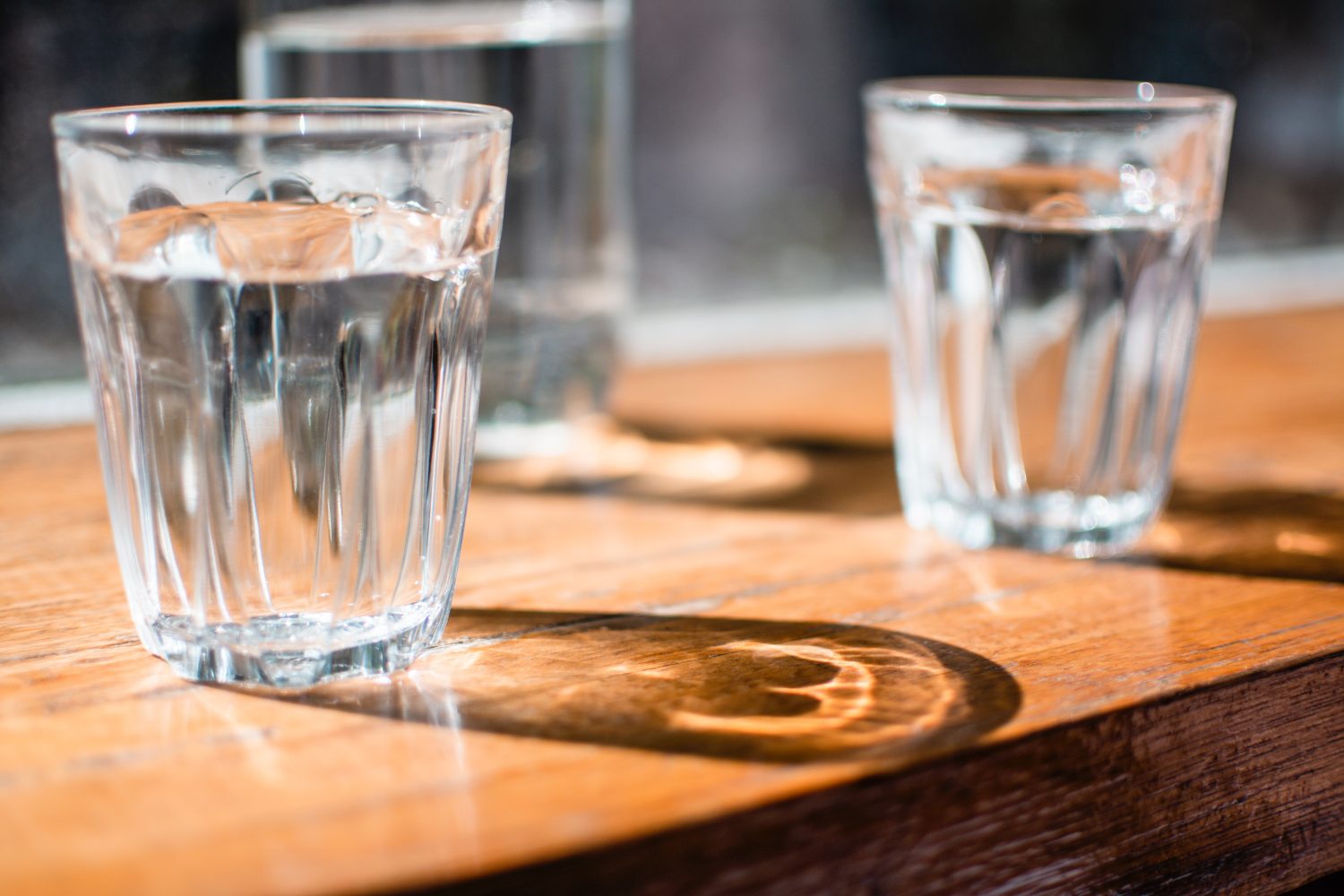
Our focus is backward. The hype should really be around proper hydration and not hitting our caffeine targets each day.
Here are some of the key benefits of drinking water; Let’s start to build the hype.
Increase oxygen throughout the body – Water is the main component of blood, which supplies cells with oxygen and nutrients and carries out waste.
Promote healthy brain function and increase mental clarity – 73% of the brain is water, so it’s understandable how big an impact hydration has on the body’s most important organ. Scientists have done studies to show that losing just 1.1% body water weight increases your neural effort when performing cognitive tasks, having an effect on short term memory, long term memory recall, arithmetic, and general problem-solving. Consuming water should allow you to think, synthesize, and act at your highest potential.
Increase energy levels and combat fatigue – Water is one of the most important energy sources in your body. It has several enzymatic functions, including contributing to good sleep, production of energy throughout the day, and restoration of bodily systems. Next time you are feeling a bit sluggish, try reaching for a glass of water in lieu of another coffee.
Prevent/treat headaches and migraines – Maybe you drank a few too many glasses of wine the night before or are simply not drinking enough water throughout the day, dehydration can often lead to the dreaded headache and even migraine. According to researchers, dehydration causes blood volume to drop, which results in less blood and oxygen flow to the brain and dilated blood vessels. Water is the catalyst for oxygen production throughout the body. Maybe it’s the missing cure for your chronic headaches.
The most common beverage you’ll find in almost every office is coffee. Coffee isn’t the evil dehydrating drink that it’s made out to be. Recent studies have shown that drinking coffee actually has a net hydrating effect. Still, multiple cups of coffee a day won’t give you the proper hydration you’re looking for.
The most significant limiting factor when it comes to workplace hydration is access. Some offices may not have a water dispenser of any sort which forces employees to either buy bottled water at the Starbucks down the street or, even worse, try to ignore their thirst. Larger offices may have a water cooler through a maze of cubicles and hallways that makes filling up a pain and not worth it. An easy way to fix this is by rearranging your layout or by adding additional sources of water.
Channel what we just talked about. 14 percent higher productivity, increased focus, added mental clarity. It’s in every office’s best interest to at least provide some water vessel to their employees. A simple water dispenser, or two, should suffice in almost any office.
For some, water can be too bland and flavorless. Luckily, we do live in the 21st century, and there seems like an infinite amount of healthy beverage options. People are becoming more health-conscious and aware of what they are consuming. Sparkling water is the big fad. Soda esque characteristics, yet hydrating and calorie-free without all the added sugars, chemicals, and whatever other ingredients that no one can pronounce without searching google. At least most of the time.
With the rise of employee perks, a number of offices now stock soda’s, seltzers, coffee, tea, you name it. There’s usually a divide in what people drink. Most are addicted to coffee, some will opt for the sugary soda, others will go for the healthier seltzer.
For the Office Managers out there – Isn’t it a pain ordering and restocking a variety of beverages for your employees, each with different preferences? What if I told you there was a suite of machines that provide delicious, customizable hydration on tap.
Bevi has a drink for everyone. Whether you’re looking for plain filtered water to keep you satiated, or your feeling a little ambitious and want to go with a fruity, sparkling option – the choice is yours. Check out how Bevi solved Medallia Food Services team’s need for variety here!
At the end of the day, how you stay healthy and hydrated is your choice to a point. If you don’t have easy access to water, then you’re at a disadvantage. Take action and get Bevi, and together let’s quest to stay hydrated!
Whether you’re thirsting for a big glass of cold water or feeling like you need just a sip, your body naturally gives you a nudge — in the form of a craving — when it’s time for a refill.
We sat down with Dr. Tom Ronay, Medical Director at Circle Medical (the doctor’s office that comes to you, paid for by your insurance, now operating in the Bay Area), for a deep dive into hydration in the workplace. Since the majority of people spend most of their waking hours at work, how you hydrate in the office can have a big impact on your our overall health.
From coffee breaks to water cooler talk, sugar rushes to BYORB (bring your own reusable bottle), Dr. Ronay provided some insight into — and tips for — healthy hydration in the workplace and beyond.
Thirst is regulated by your blood vessels and kidneys via a complex and very fast-acting cascade that triggers your brain to crave fluids of any kind. This process all happens automatically: the human body is excellent at regulating hydration and is faster than any laboratory test out there. 1 out of 4 office employees say they don’t hydrate enough.
Access is key. Some offices may not have a filtered water cooler, which forces employees to either buy bottled water at the Starbucks down the street or to try and ignore their thirst. Given that proper hydration can increase employee productivity up to 14%, it’s in every office’s best interest to provide a consistent and healthy source of beverages to their employees. In some larger offices, the water cooler might be tucked away in the corner or halfway across the floor. Small layout changes or adding additional hydration stations is a great way to give employees more immediate access to water.

Another key factor is how you decide to quench your thirst. When you feel thirsty, in reality any fluid can quench that initial thirst, but only some fluids — the healthy ones — will keep you hydrated and balanced.
Coffee is limited in how well it can hydrate you. It is in fact a diuretic, meaning it can actually cause you to lose more fluid than you gain. Similarly, it also can move your intestines more quickly than is typically comfortable. It doesn’t have to be coffee either — really any caffeinated drink will have this effect on the body, so it’s hard to work around it. While it is better than nothing, drinking coffee all day isn’t exactly the best way to keep yourself hydrated and focused in the office.
How we metabolize caffeine is different from the way in which our body processes something like alcohol. Caffeine is metabolized and removed from your body quickly at first, but after about 4–6 hours its metabolized much slower, meaning it sticks around in our bodies for a fairly long time.
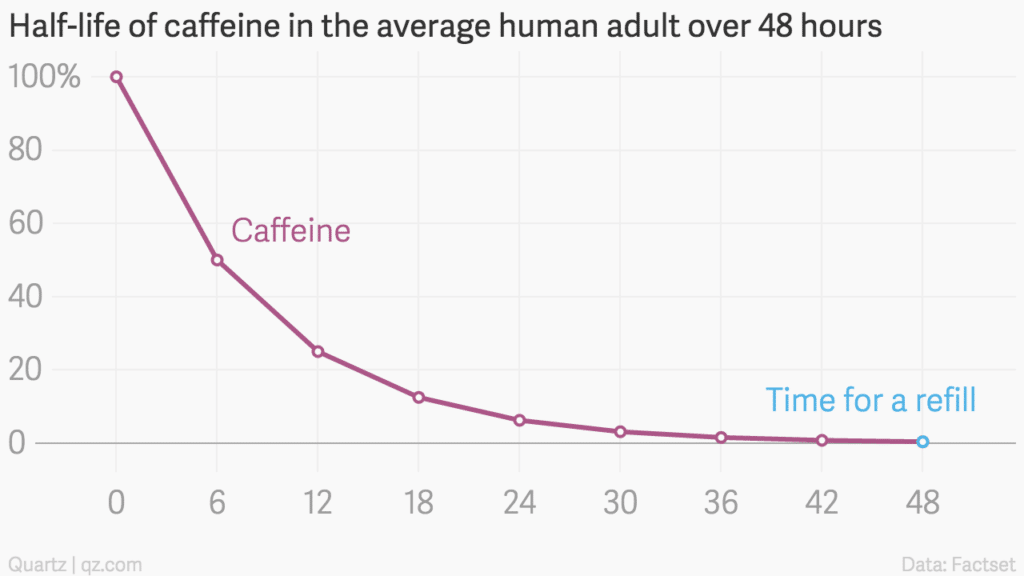
Contrary to common thought, coffee does affect people in the evening, sometimes even disrupting sleep. Besides disrupting the amount of sleep, it can really affect the quality of sleep you get; the time you spend sleeping becomes inefficient, meaning you require more sleep to compensate.
Coffee may give you that extra boost you need to finish out the workday, but it will ultimately affect the amount of rest you get after work.
Forcing or shaming people to drink water is counterproductive, especially when there are many creative ways to integrate hydration into your typical office routine. For example, in our office, each person has their favorite mug, cup or glass. These personalized mugs or special glasses are fun and almost a form of personal expression.
Having a unique drinking vessel not only encourages people to fill up their glass, but also helps to lessen the occurrence of anonymous dirty cups in the sink.
The variety of alternatives out there is amazing. Many office now stock cold, fizzy drinks, hot drinks like tea, and everything in between!
In recent years, there’s been a national decrease in soda consumption and an increase in demand for healthier alternatives. People are now getting into different types of waters, such as mineral water, seltzer water, and fruit-flavored water, that are more satisfying alternatives to sugary carbonated drinks.
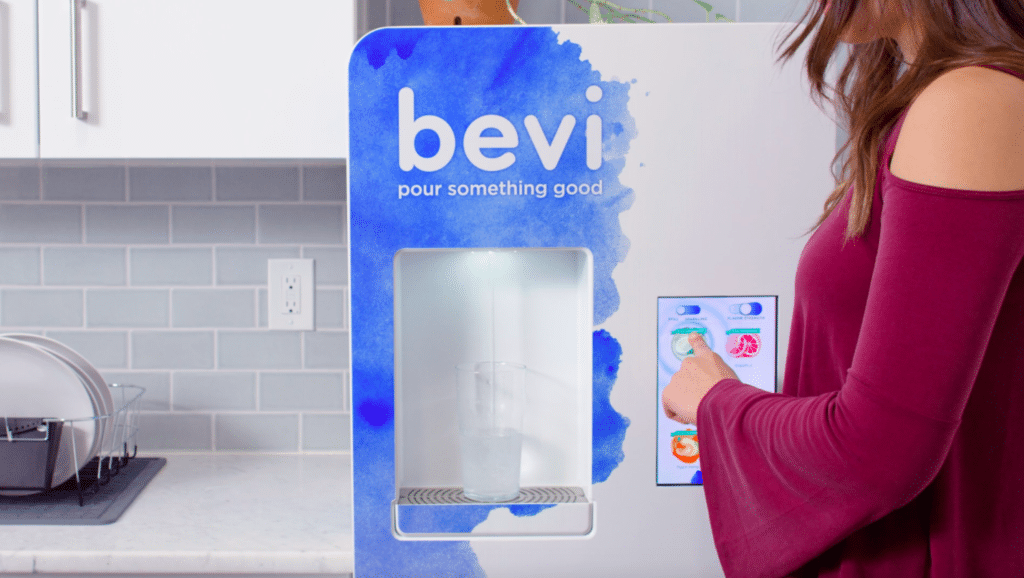
For offices that have a mixture of water drinkers and soda lovers, Bevi is a great compromise. Plain water drinkers can have their fill of plain filtered water, while soda lovers can make the transition to Bevi’s unsweetened fruit flavors.
As young doctors in training, we learned that providing access to hydration was all that was needed for most of our hospitalized patients. Our patients did not require precise measurements or IV hydration, unless they were immobile or elderly. If you provide access to water, the patient will take care of the rest.
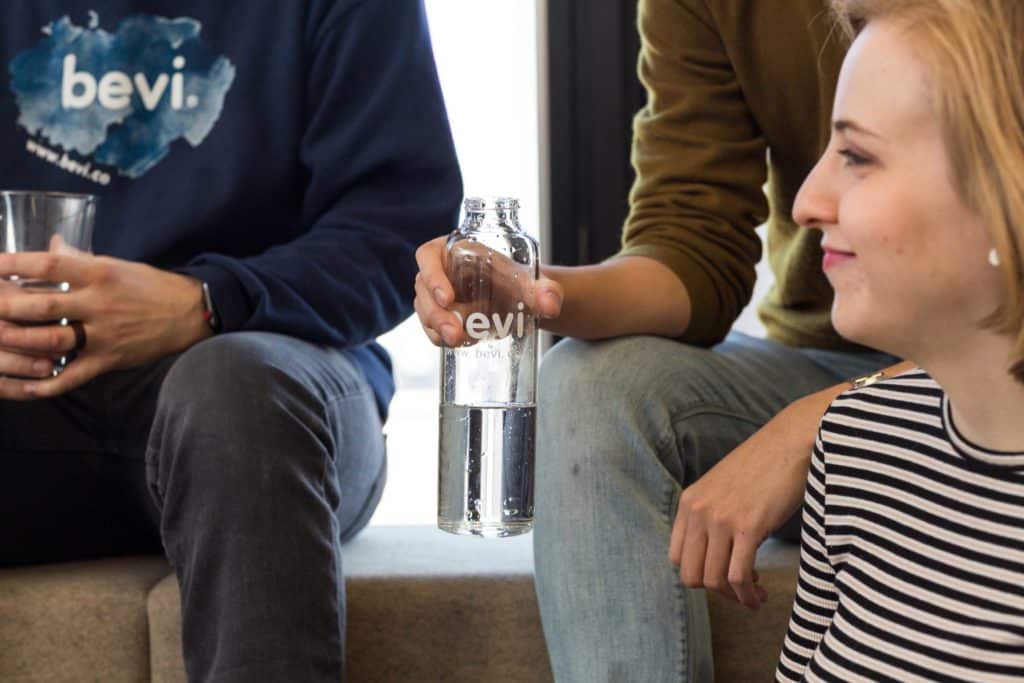
The same thing goes for flu or cold prevention in the office. Sometimes offices will provide their employees with Vitamin C during flu and cold season, but an initiative to hydrate more frequently could have an even bigger impact.
Keep in mind that our bodies are primarily water — somewhere around 60–78%. In general, our bodies are made up of elements that are subject to the laws of chemistry and physics, and therefore have many complex reactions. This means if you’re drinking poor quality water or your water level is simply low, you’re at a serious disadvantage on a chemical level.
In my own life, I have received a lot of conflicting advice on this point. My Sergeant in the Air Force always used to say “Drink water until you pee clear,” but this conflicted with what my marathon doctor advised me; he always emphasized that over-hydrating is a real risk for competitors.
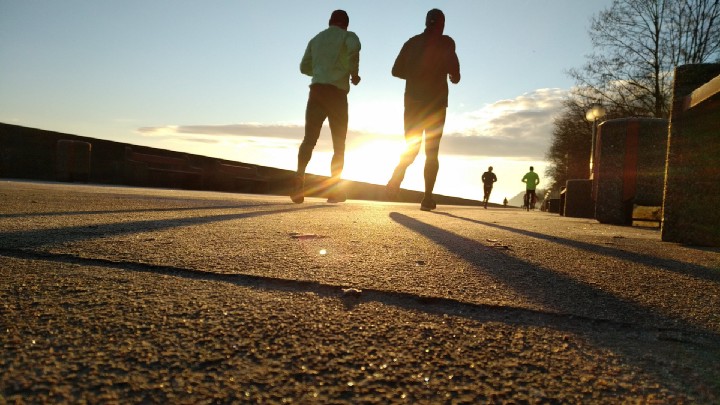
These combined experiences taught me that forcing water on people (or in this case, marathon runners) was annoying and counter-productive, but providing access to water was critical in any situation. Unless someone is elderly or has limited access to hydration, they will most likely drink as much water as they need.
I will admit that I drink one cup of coffee at the office, and I could definitely do more to keep myself consistently hydrated. Having a Bevi in the office would certainly help me take care of that!